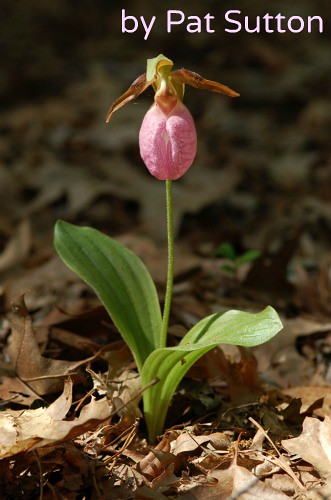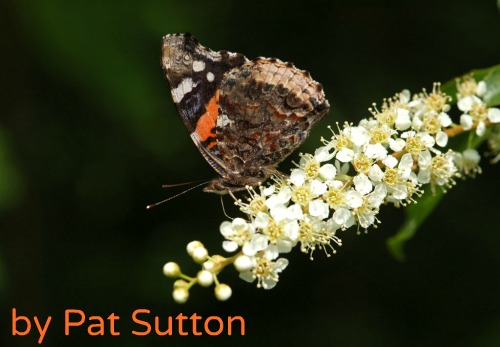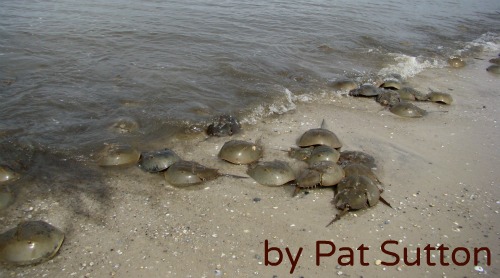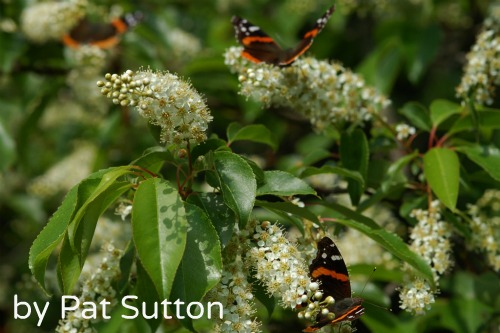
Hi Gang,
I’ve had lots and lots of wildlife gardeners all over New Jersey and the Northeast share their Red Admiral sightings with me. Hopefully you saw some of this mega flight yourself, involving many millions of Red Admirals, so many that cars everywhere couldn’t help but hit hundreds (or probably thousands) of them some days.

My fist awareness of the MEGA Red Admiral movement was on May 1st, the day we returned from presenting a program to Chesapeake Audubon Society in Maryland. Our lilacs were covered with them. We’d just learned that Pink Lady-Slippers were blooming, so visited a woods along Kimbles Beach Road in the Cape May NWR to see them and were astounded by the 100s of Red Admirals (and lesser numbers of American Ladies, Question Marks, and Painted Ladies) pouring out of the woods, all dashing north. That evening I drove to Wildwood on an errand and the flight continued the entire length of my drive . . . I saw 100s of Red Admiral pouring north everywhere along the way, so many that I couldn’t help but hit my fair share of them.


May 3rd I stopped what I was doing (preparing for a “Backyard Habitat for Birds, Butterflies, Dragonflies, and More!” workshop) to drink in the explosion of Red Admirals nectaring on Black Cherry trees. I’d never seen anything like it and could only compare what I was seeing to a butterfly house (where 100s or 1000s of butterflies are raised and released every day into an enclosed butterfly house to entertain visitors). The numbers on each blooming Black Cherry tree were off-the-charts. Every few seconds 100s exploded out of the tree, to land again and continue nectaring. The tree seemed alive with Red Admirals. It was hard to capture on film, so I focused on some portraits of nectaring Red Admirals and Question Marks and American Ladies. I had to pull myself away to get back to work.
May 6th I visited Cape May NWR woodlands on Kimbles Beach Road to show a friend an enormous Red Cedar I’d found (8′ 7″ around at chest height), a real big’n. It was about 10:00 a.m. and we saw a few Red Admirals flitting about. But when we entered the woods it was like entering a magic woodland, in that every sunlit patch of the forest floor was covered with 20-40 Red Admirals (and lesser numbers of Question Marks and American Ladies) that lifted off the forest floor, sailed around, then settled back down onto the forest floor to warm up for the day. We ended this visit by driving the road out to the Delaware Bay shoreline and were dazzled by another natural history show unfolding, 100s of Horseshoe Crabs tumbling in the tideline, mating.

May 8th I was interviewed by Phaedra Laird of NBC 40 WMGM-TV and her cameraman, wanting to learn of the Red Admiral migration. Numbers had dropped off. The Black Cherry trees were still in full flower, but Red Admirals were not in attendance. But our Stinging Nettle patch was another story. I’d dared to plant it in our wildlife garden, just for Red Admirals. I was able to point out Red Admiral eggs on the leaves of my Stinging Nettle. The more I looked, the more I found, until I realized that the patch supported 100s and 100s of eggs. Several female Red Admirals were in attendance, laying more, one after the next. We peeked inside a curled-shut leaf and found a teeny-tiny Red Admiral caterpillar.
Rick Cech and Guy Tudor’s great book, Butterflies of the East Coast, An Observer’s Guide, shares the following really cool natural history information. Red Admirals withdraw from the North each fall and maintain thin, permanent resident populations from the Carolinas south. They steadily repopulate the north every spring, but this movement north usually goes unnoticed. Though about once every 10 years, massive spring flights on the East Coast have been documented: 1981, 1990, 2001, and now 2012. This year’s MEGA flight could be due to the mild winter where many more Red Admirals survived the winter to mate and lay eggs and grow in number until this explosion north.

Looking back at my notes from the May 5-8, 1990 flight Clay reminded me that we’d found 100s washed ashore along the ocean front, individuals that had been blown offshore and never made it back to land. Let’s hope that this flight has not triggered something similar.
Jack Connor has compiled many observations and counts tallied by naturalists all over South Jersey of this MEGA May 2012 Red Admiral spring migration. Go to his South Jersey Butterfly Blog to read these fun accounts: as of May 7 and as of May 5.
